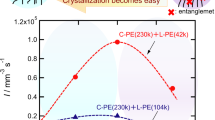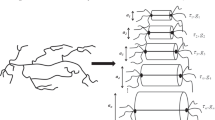Abstract
We propose molten polymer’s entanglement network deformation to be nonaffine and use transient network structural theory with the revised Liu’s kinetics rate equation and the revised upper convected Maxwell constitutive equation to establish a nonaffine network structural constitutive model for studying the rheological behavior of molten Low-Density Polyethylene (LDPE) and High-Density Polyethylene (HDPE) in oscillatory shear. As a result, when the strain amplitude or frequency increases, the shear stress amplitude increases. At the same time, the accuracy of the nonaffine network model is higher than that of affine network model. It is clear that there is a small amount of nonaffine network deformation for LDPE melts which have long-chain branches, and there is a larger amount of nonaffine network deformation in oscillatory shear for HDPE melts which has no long-chain branches. So we had better consider the network deformation nonaffine when we establish the constitutive equations of polymer melts in oscillatory shear.
Similar content being viewed by others
References
Qu Jinping. Studies on conveying and extrusion process, behavior and response of polymer melt under the vibration force field[D]. Dissertation of Doctoral Degree, Sichuan University, 1999 (in Chinese).
Lodge A S. A network theory of flow birefringence and stress in concentrated polymer solutions [J]. Transactions of the Faraday Society, 1956,52:120–130.
Marrucci G, Titomanlio G, and Sarti G C. Testing of a constitutive equation for entangled networks by elongational and shear data of polymer melts[J]. Rheologica Acta, 1973,12: 269–275.
Giacomin A J, and Jeyaseelan R S. A constitutive theory for polyolefins in large amplitude oscillatory shear, Polymer Engineering and Science, 1995,35: 768–777.
Phan-Thien N. A nonlinear network viscoelastic model [J]. Journal of Rheology, 1978,22: 259–283.
Larson R G. A constitutive equation for polymer melts based on partially extending strand convection[J]. Journal of Rheology, 1984,28:545–571.
Giacomin A J. and Jeyaseelan R S. How affine is the entanglement network of molten low-density polyethylene in large amplitude oscillatory shear? [J]. Transactions of the ASME, 1994,116:14–18.
Liu T Y, Soong D S. and Williams M C. Time-dependent rheological properties and transient structural states of entangled polymeric liquids —A kinetic network model[J]. Polymer Engineering and Science, 1981,21:675–687.
Giacomin A J, Jeyaseelan R S, Samurkas T, and Dealy J M. Validity of separable BKZ model for large amplitude oscillatory shear[J]. Journal of Rheology, 1993,37(5): 811–826.
Author information
Authors and Affiliations
About this article
Cite this article
Zhang, J., Qu, JP. Nonaffine network structural model for molten Low-Density polyethylene and High-Density Polyethylene in oscillatory shear. J. of Shanghai Univ. 6, 292–296 (2002). https://doi.org/10.1007/s11741-002-0053-9
Received:
Revised:
Issue Date:
DOI: https://doi.org/10.1007/s11741-002-0053-9




